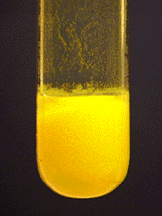

Then we have led to nitrate combining with hydrochloric acid when cat eye and switch places led to well combined with chloride, led to with the two plus charge combines with chloride with a one minus charge, so we'll need to chlorides According to the scalability rules, all chlorides are soluble, except for the three exceptions where one of them is led to chloride, so lead to chloride is the precipitate. And as I mentioned, all sulfates and ionic compounds with alkali metals are soluble according to Rules number two and four, So no precipitate forms in this chemical reaction. So this is according to rule number three. Iron to iron to chloride is going to be soluble because all chlorides are soluble, except for the three exceptions that were provided where iron too, is not one of them. We will need to chlorides for every iron two plus according to sell ability rules. According to scalability rules, all sulfates are soluble, and anything combined with an alkali metal such as potassium is also soluble when iron too, complains with chloride iron two with the two plus charge and chloride with a one minus charge.

When combined with sulfate, having a Tu minus charge requires two. For the next one, we have potassium chloride, combining with iron to sulphate potassium with a one plus charge. When we balance, the reaction will put a two in front of the sodium nitrate so that we have to sodium and to nitrates on both sides. So barium sulfate being one of the exceptions for sulphate is insoluble, and this is our precipitate. According to the scalability rules, all sulfates are soluble, except for the three exceptions lead to sulphate, calcium sulfate and barium sulfate. Then bury him with a two plus charge goes with sulfate that has the two minus charge, so we just need one of each of them.

Having a one plus charge goes with nitrate having a one minus charge, and we only have one of each of them. When the cat eye on switch places sodium. Next, we have barium nitrate combining with sodium sulfate. Therefore, iron three phosphate would be our precipitate. According to last rule, phosphates are all insoluble. Except for the three exceptions which HCL is not so HCL is soluble. We have three chlorides and only one chloride, so we need to put a three in front of the HCL Then, According to scalability rules, all chlorides are soluble. When iron three plus combines with phosphate iron three plus having a three plus charge and phosphate having a three minus charge, just one of each of them combined, then we need to balance it. So when hydrogen combines with chloride having a one minus charge, only one of each of them combined. Remember when the cat eye on switch places though iron has the three plus charge, hydrogen has a one plus charge.

We will end up with the potential products of hydrogen chloride or hydrochloric acid and iron three phosphate. It's a cat ions, iron three and hydrogen switch places. So in this case, we have iron three chloride, combining with phosphoric acid. We simply need to write a balanced chemical reaction, recognizing that in all of these chemical reactions, the cat ions switch places. And if no precipitate occurs, uh indicates the rules that apply, suggesting no precipitate will occur to predict the precipitate that forms. Based upon this eligibility rules provided in table 71 you are asked to determine what the precipitate is. For this next question, we are given to compounds that serve as reactant for a potential precipitation reaction.


 0 kommentar(er)
0 kommentar(er)
